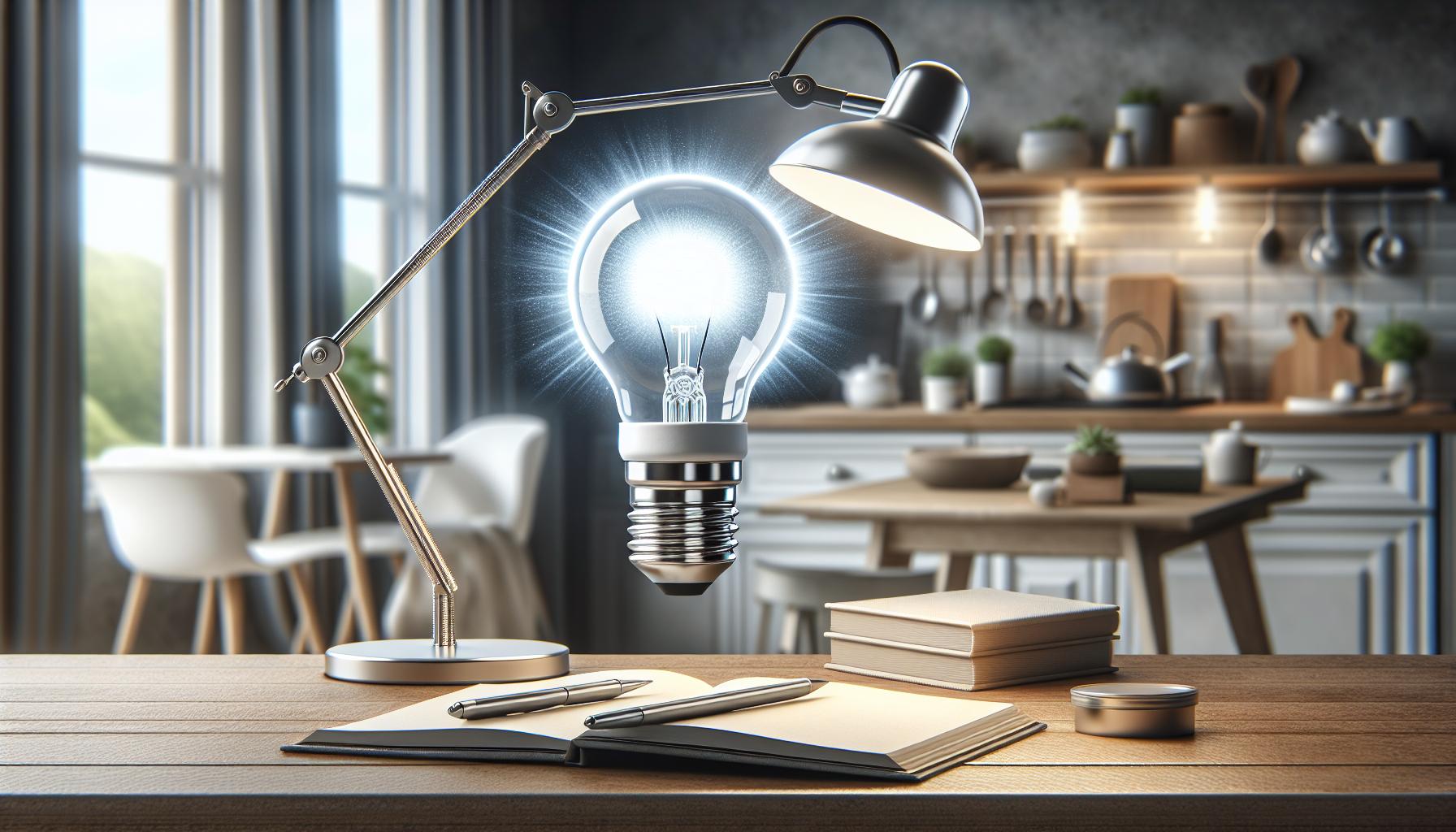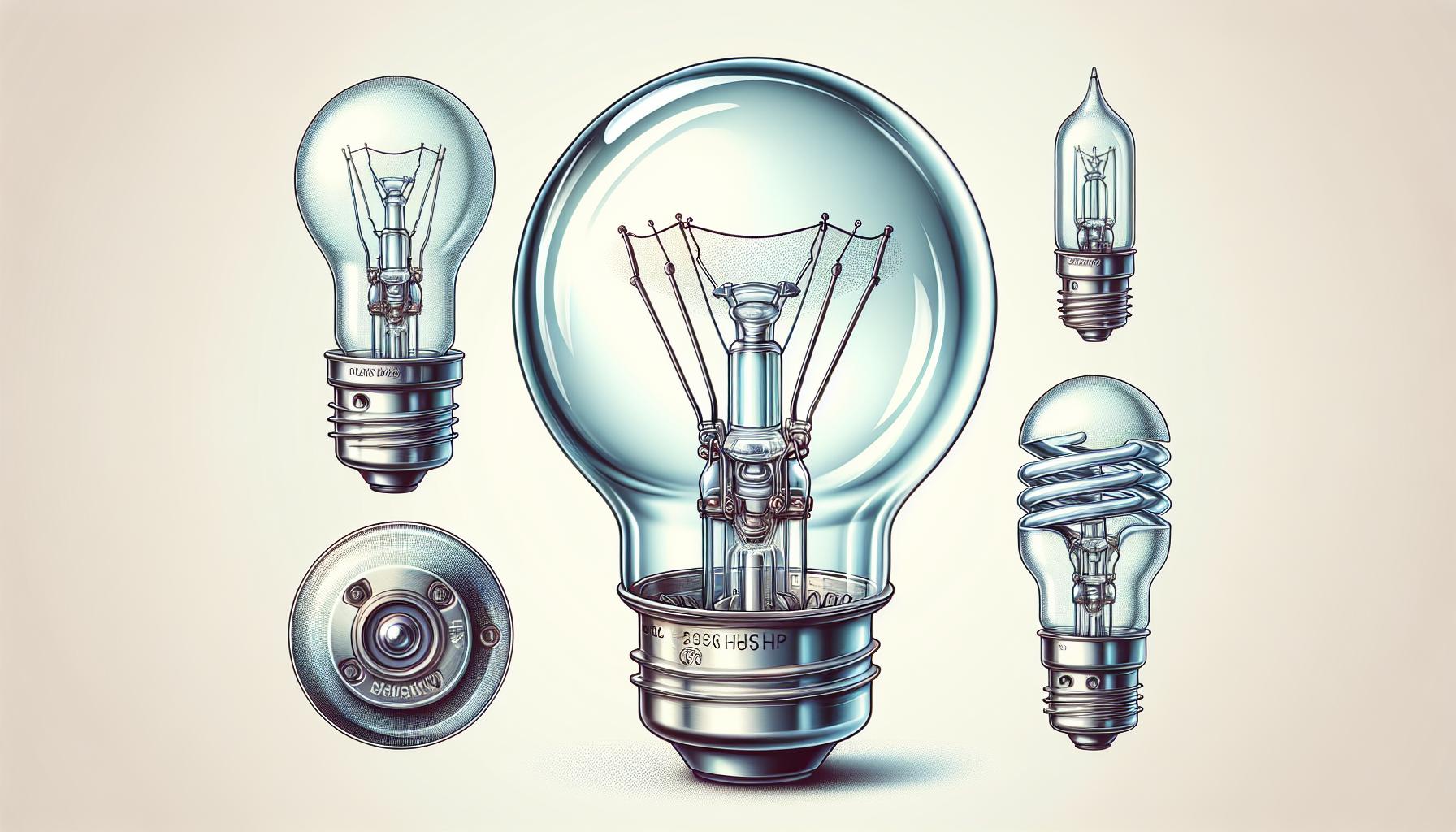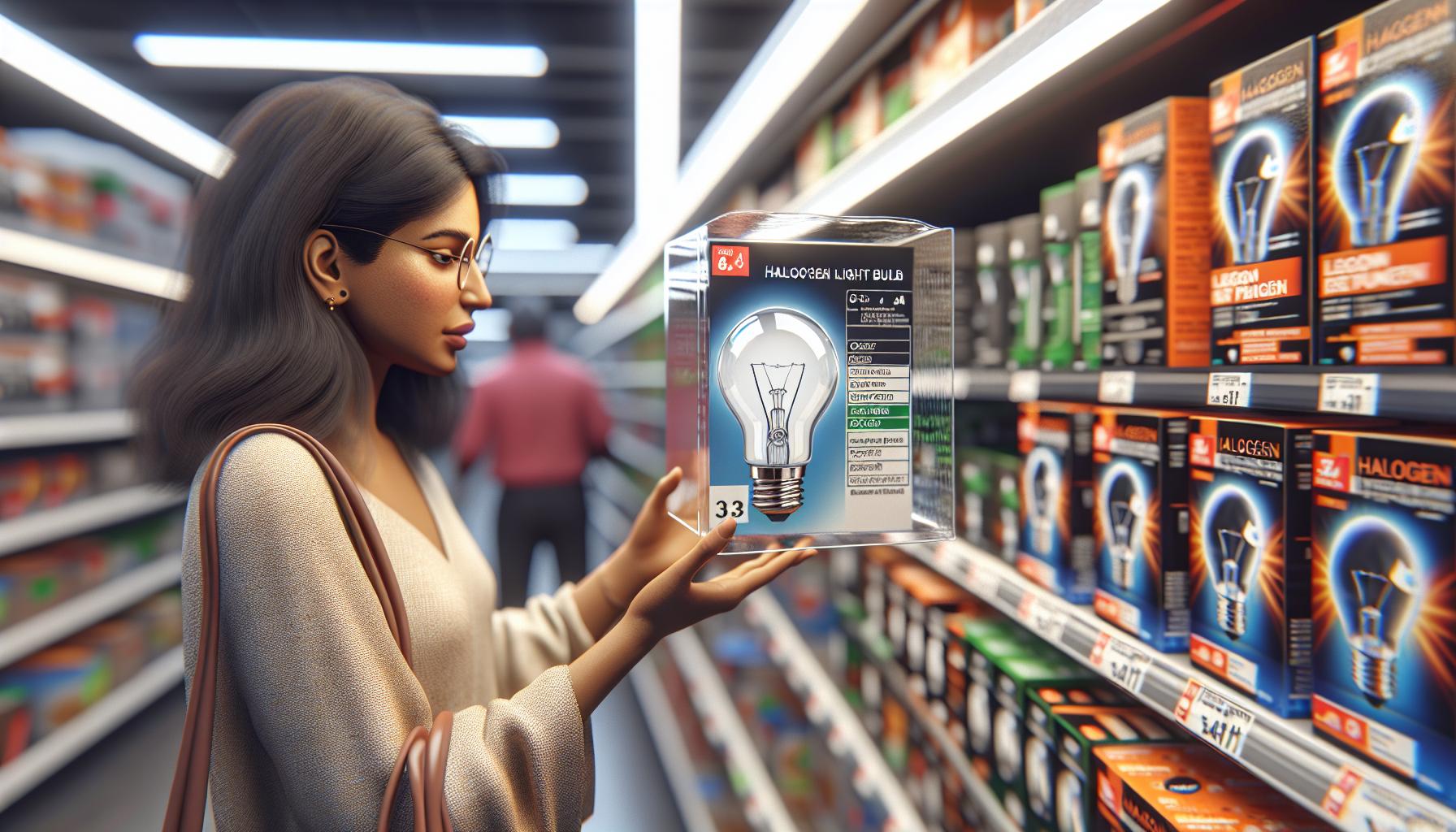Ever found yourself staring at a light bulb and wondering if it’s a halogen? You’re not alone! Identifying light bulbs isn’t always straightforward, but it’s handy to know, especially when you’re looking to replace or upgrade them.
Halogen bulbs have a distinct look and feel, and knowing these can save you a trip to the store or a call to a professional. Let’s dive into the tell-tale signs that’ll help you spot a halogen bulb with just a glance.
How to Identify a Halogen Light Bulb
When you’re on a mission to pinpoint the halogen bulbs in your home, keep an eye out for a few telltale features.
Firstly, inspect the bulb’s size and shape. Halogen bulbs typically have a compact form, often spherical or tubular, with two prongs at the base instead of the usual screw fitting. They’re smaller than the traditional incandescent bulbs you might be more familiar with.
Examine the bulb’s glass. Halogen bulbs are made of quartz, tougher than standard glass, to withstand higher temperatures. If you see a bulb with a translucent, strong glass, chances are it’s a halogen. But handle with care – oils from your skin can damage the quartz and shorten the bulb’s lifespan when heated.
Next, look at the light output. Halogens give off a bright, white light, much crisper than the yellow hue of incandescent bulbs. This intense illumination is top-notch for task lighting or accentuating artwork in your DIY home projects.
If you’re still unsure, check the label or packaging for the word “halogen”. Sometimes the easiest way to confirm is simply by reading what’s written by the manufacturer.
Remember, always turn off the electricity before inspecting any bulb to prevent any shock or injury. Safety first – you’re not just a DIY enthusiast but a smart one too.
Here’s a handy table to recap:
| Feature | Description |
|---|---|
| Size & Shape | Compact, spherical, or tubular with prong base |
| Glass Type | Quartz; withstands high temperatures |
| Light Output | Bright, white light |
| Label Information | Word “halogen” indicated |
Understanding the Characteristics of Halogen Bulbs
Halogen bulbs stand out due to unique physical characteristics that distinguish them from other light sources. First, you’ll notice their compact design. Halogens are generally smaller than traditional incandescent bulbs, providing an intense light from a smaller form factor that fits perfectly in your desk lamp or a stylish pendant.
Bright, Crisp Light is another hallmark of halogen bulbs. They emit a bright white light—often resembling natural daylight—which is ideal for tasks that require attention to detail. This makes halogen lighting a favorite for places like your home office or kitchen where you’re focusing on intricate projects or whipping up your next culinary delight.
Heat Output should also be kept in mind. Halogens get fairly hot to the touch, much hotter than their LED or fluorescent counterparts. That’s because they operate at higher temperatures, which is part of what gives them their bright light, but it also means you’ll want to be careful when handling them.
One of the technological aspects that you’ll find interesting is the filament. Halogen bulbs use a tungsten filament, much like old-school incandescent bulbs. However, in halogens, the filament is surrounded by halogen gas. When you power on the bulb, the tungsten filament heats up, and a reaction with the gas occurs, which actually helps re-deposit evaporated tungsten back onto the filament. This little bit of science is what helps extend the life of halogen bulbs beyond that of traditional incandescents.
« How to Know if Light Bulbs Are Dead: Quick Diagnosis Tips
Are Light Bulbs Different Sizes? Discover the Best Fit for Your Home »
Directly following the technological breakdown, it’s necessary to mention the Energy Efficiency aspect. While not as energy-efficient as LEDs, halogen bulbs do consume about 20-30% less energy compared to traditional incandescent lights. This makes them a somewhat more efficient option if you’re not quite ready to transition fully to LED technology.
Remember, identifying halogen bulbs isn’t just about the light they emit or their appearance; it’s also about acknowledging their functionality and where they can best serve your lighting needs around the home. Whether it’s the focused light for your DIY projects or a cozy ambiance for your relaxation spaces, halogens can be the right choice for the right situation.
The Appearance of Halogen Bulbs
When you’re on the hunt to pinpoint halogen light bulbs, there’s an array of distinctive features to look for. You’ll immediately notice the bright, white light they emit, which not only adds clarity to any space but also makes colors pop with vibrancy. On the hardware front, halogen bulbs are usually made with quartz instead of glass due to their higher operating temperatures. The quartz enclosure is clearer and often much thinner than the typical glass you’d find on other bulbs.
Halogen bulbs stand out with their compact design; they’re typically smaller than standard incandescent bulbs. If you’re browsing through options, you may encounter a variety of shapes such as tubular (T-bulbs), spotlights (PAR bulbs), or even decorative candle-style bulbs. Despite the variation in form, what they all share is a well-defined shape that’s precision-built for their application.
In your DIY adventures, you might have come across the term ‘capsule bulbs‘. These little guys are a stellar example of halogens’ versatility. Often used in desk lamps and pendant lights, they pack a punch in a small package. But don’t be fooled by their size – their light is as intense and focused as their larger counterparts.
Diving deeper into appearance, halogen bulbs have a couple of noteworthy identifiers. Look for the pressed glass at the base of the bulb (it’s the part where the glass joins the metal). Also, snoop for a cylindrical or rounded bulb with a smooth exterior; this is a classic halogen giveaway.
Keep in mind that wattage and lumens also play a part in identification. Halogens generally come in a higher wattage range for their size compared to incandescents, with lumens often surpassing those of similar-sized bulbs. Always handle with care and make sure the power is off when examining these features.
Armed with these insights, you’re well on your way to distinguishing halogen bulbs from the pack. Whether it’s the radiant light, the unique construction, or the diverse shapes, you’ll spot them like a pro. Now, let’s shine a light on how to select the right halogen for your specific needs.
Identifying Halogen Bulbs Through Packaging
When you’re navigating the lighting aisle, the packaging is your first clue in determining if you’ve picked up a halogen bulb. Manufacturers often highlight the halogen designation prominently due to their energy efficiency and intense brightness advantages over traditional incandescent bulbs. Here’s what to keep an eye out for on the packaging:
- Look for the word ‘Halogen’: It’ll likely be in bold lettering or a unique color to stand out.
- Check the energy information: Packages typically indicate the bulb’s wattage and lumens. Remember, halogen bulbs have a higher lumens-to-watt ratio than incandescent bulbs, offering more light per unit of energy.
- Symbol for dimmer compatibility: Many halogen bulbs work with dimmers, a feature usually symbolized with a dimmer icon or text.
- Lifespan: Halogens generally have a longer lifespan than incandescents. This detail should be highlighted, so keep your eyes peeled for lifespan information.
Be aware of the bulb’s appearance through the packaging’s transparent section. If you’ve read the previous parts of this article, you know the telltale signs—bright white light and compact design.
Additionally, certifications and warnings are crucial markers on the packaging. Look out for:
- Safety certifications indicating the bulb meets certain safety standards.
- Warnings about handling: These will remind you to avoid touching the bulb with bare hands due to oils affecting the quartz.
Lastly, consider the environmental claims. Halogen lights are often touted as eco-friendlier options. Though not as energy-efficient as LEDs or CFLs, they’re certainly an improvement over incandescent bulbs and often carry a lower environmental impact statement on their packaging.
Conclusion
You’ve got all the tips you need to pinpoint a halogen bulb now. Remember the key features—size, shape, and brightness—and don’t forget to peek at the packaging for those telltale signs. With the right knowledge, you’ll not only identify halogen bulbs with ease but also handle them safely. Next time you’re bulb shopping, you’ll be ready to make an informed decision, keeping in mind the bulb’s longevity, safety, and environmental impact. Happy lighting!
Frequently Asked Questions
What are the key features to look for when identifying a halogen light bulb?
Halogen bulbs can be identified by their size, shape, and the type of glass used. They typically have a bright, intense light output and need to be handled with care.
How do I safely inspect a halogen bulb?
Always turn off the electricity before inspecting a halogen bulb. Handle the bulb gently to avoid damage and ensure your safety.
Can halogen bulb packaging help with identification?
Yes, the packaging often has distinct indications such as the word ‘Halogen’ in bold lettering, information on wattage and lumens, and symbols for dimmer compatibility.
What should I check in the energy information on the packaging of a halogen bulb?
Look for the wattage and lumens listed on the packaging to understand the energy consumption and light output of the halogen bulb.
Are there specific symbols on halogen bulb packaging indicating dimmer compatibility?
Yes, look for symbols or mentions on the packaging that indicate whether the halogen bulb is compatible with dimmer switches.
Why is the bulb’s lifespan important when selecting a halogen bulb?
A bulb’s lifespan indicates how long you can expect the bulb to last, which affects replacement frequency and long-term cost.
How do safety certifications on halogen bulbs impact my purchase?
Safety certifications ensure that the halogen bulb has passed specific industry standards for safe operation, which is crucial for consumer trust and product reliability.
What kind of warnings about handling should I look for when buying a halogen bulb?
Look for warnings that advise against touching the bulb with bare hands, as oils from the skin can affect the lifespan and performance of the bulb.
Are environmental claims important when selecting halogen bulbs?
Environmental claims, such as energy efficiency or reduced emissions, can guide you to more eco-friendly options for halogen bulbs.




